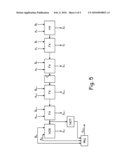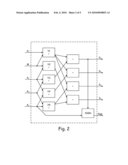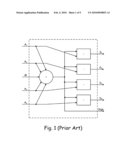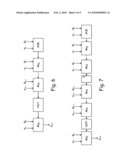Patent application title: Variable Node Processing Unit
Inventors:
Alexander Andreev (San Jose, CA, US)
Sergey Gribok (San Jose, CA, US)
Oleg Izyumin (Los Gatos, CA, US)
Assignees:
LSI Corporation
IPC8 Class: AG06F1100FI
USPC Class:
708531
Class name: Arithmetical operation error detection or correction parity check
Publication date: 2010-02-04
Patent application number: 20100030835
Inventors list |
Agents list |
Assignees list |
List by place |
Classification tree browser |
Top 100 Inventors |
Top 100 Agents |
Top 100 Assignees |
Usenet FAQ Index |
Documents |
Other FAQs |
Patent application title: Variable Node Processing Unit
Inventors:
Alexander Andreev
Sergey Gribok
Oleg Izyumin
Agents:
LNG/LSI JOINT CUSTOMER;C/O LUEDEKA, NEELY & GRAHAM, P.C.
Assignees:
LSI CORPORATION
Origin: KNOXVILLE, TN US
IPC8 Class: AG06F1100FI
USPC Class:
708531
Patent application number: 20100030835
Abstract:
A variable node processing unit with N+1 inputs, having at least a first
bank of two-input adders and a separate last bank of two-input adders,
where the banks of adders are disposed in series.Claims:
1. A low-density parity check min-sum decoder including a variable node
processing unit comprising N+1 inputs, at least a first bank of two-input
adders and a separate last bank of two-input adders, with the banks of
adders disposed in series, a sign module for outputting a sign value, and
N+1 outputs, where one of the outputs is the sign value.
2. The variable node processing unit of claim 1, wherein N=4, the first bank of adders is designated as the Y adders and the last bank of adders is designated as the S adders, the inputs are A1, A2, A3, A4, and M, the outputs are S1, S2, S3, S4, and SIGN, and the variable node processing unit processes according to equations:y1=M+A1,y2=M+A2,y3=A2+A3,y4=A2+A4,y5=A3+A4,S1=y2+y5,S2=y1+y5,S3- =y1+y4,S4=y1+y3, andSIGN=sign(A4+S4).
3. The variable node processing unit of claim 1, wherein at least one of the two-input adders is a Signed Ripple-Carry adder.
4. The variable node processing unit of claim 1, wherein at least one of the two-input adders is a Signed Ripple-Carry adder that includes logic elements and a flip-flop interjected between two adjacent ones of the logic elements.
5. The variable node processing unit of claim 1, wherein the sign module comprises a chain of majority cells that calculate the sign value without calculating a corresponding sum value.
6. The variable node processing unit of claim 1, wherein the sign module comprises a chain of majority cells that calculate the sign value without calculating a corresponding sum value, including a flip-flop interjected between two adjacent ones of the majority cells.
7. A low-density parity check min-sum decoder including a variable node processing unit comprising N+1 inputs, at least a first bank of two-input adders and a separate last bank of two-input adders, with the banks of adders disposed in series, a sign module for outputting a sign value, and N+1 outputs, where one of the outputs is the sign value, and each of the two-input adders is a Signed Ripple-Carry with logic elements and a flip-flop interjected between two adjacent ones of the logic elements.
8. The variable node processing unit of claim 7, wherein N=4, the first bank of adders is designated as the Y adders and the last bank of adders is designated as the S adders, the inputs are A1, A2, A3, A4, and M, the outputs are S1, S2, S3, S4, and SIGN, and the variable node processing unit processes according to equations:y1=M+A1,y2=M+A2,y3=A2+A3,y4=A2+A4,y5=A3+A4,S1=y2+y5,S2=y1+y5,S3- =y1+y4,S4=y1+y3, andSIGN=sign(A4+S4).
9. The variable node processing unit of claim 7, wherein the sign module comprises a chain of majority cells that calculate the sign value without calculating a corresponding sum value.
10. The variable node processing unit of claim 7, wherein the sign module comprises a chain of majority cells that calculate the sign value without calculating a corresponding sum value, including a flip-flop interjected between two adjacent ones of the majority cells.
11. A low-density parity check min-sum decoder including a variable node processing unit comprising N+1 inputs, at least a first bank of two-input adders and a separate last bank of two-input adders, with the banks of adders disposed in series, a sign module for outputting a sign value, and N+1 outputs, where one of the outputs is the sign value, and each of the two-input adders is a Signed Ripple-Carry adder with logic elements and a flip-flop interjected between two adjacent ones of the logic elements, and the sign module includes a chain of majority cells that calculate the sign value without calculating a corresponding sum value, with a flip-flop interjected between two adjacent ones of the majority cells.
12. The variable node processing unit of claim 11, wherein N=4, the first bank of adders is designated as the Y adders and the last bank of adders is designated as the S adders, the inputs are A1, A2, A3, A4, and M, the outputs are S1, S2, S3, S4, and SIGN, and the variable node processing unit processes according to equations:y1=M+A1,y2=M+A2,y3=A2+A3,y4=A2+A4,y5=A3+A4,S1=y2+y5,S2=y1+y5,S3- =y1+y4,S4=y1+y3, andSIGN=sign(A4+S4).
Description:
FIELD
[0001]This invention relates to the field of integrated circuit design. More particularly, this invention relates to an efficient hardware implementation of a variable node processing unit (VNU) inside of a low-density parity check (LDPC) min-sum decoder.
BACKGROUND
[0002]Low density parity-check (LDPC) codes were first proposed by Gallager in 1962, and then "rediscovered" by MacKay in 1996. LDPC codes have been shown to achieve an outstanding performance that is very close to the Shannon transmission limit. However it is very difficult to build an efficient hardware implementation of a circuit for decoding LDPC codes. All existing hardware implementations of LDPC decoding algorithms suffer from low speed and large area and power requirements. It is very important to develop an LDPC-decoder that has better speed, area, and power characteristics than the existing implementations.
[0003]The most promising algorithm for decoding LDPC-codes is so the called min-sum algorithm. Generally speaking this algorithm performs two main operations [0004]1. Find a minimum number among a given set of signed numbers, and [0005]2. For a given group of signed numbers A1, . . . , AN and a signed number M calculate:
[0005]Si=S-Ai, where i=1, . . . N, S=A1+ . . . +AN+M, and
SIGN=sign(S)={0, if S≧0; 1, if S<0}.
[0006]A typical hardware implementation of this algorithm represents the LDPC decoder as a set of multiple node processing units performing operations (1) and (2) as given above. There are two types of units: [0007]1. So-called "check node processing units" (CNU) that perform operation (1), and [0008]2. So-called "variable node processing units" (VNU) that perform operation (2).
[0009]The decoder may contain up to thousands of these two units working in parallel. One hardware realization of a VNU as depicted in FIG. 1 contains N-input adder module (denoted by the "+" sign) for calculating the total sum S, and N two-input subtractor modules (denoted by the "-" sign) for calculating "partial" sums Si.
[0010]What is needed, therefore, is a VNU that improves--at least in part--the speed, area, and power characteristics of the VNU, and therefore enables the construction of a better LDPC decoder.
SUMMARY
[0011]The above and other needs are met by a variable node processing unit with N+1 inputs, having at least a first bank of two-input adders and a separate last bank of two-input adders, where the banks of adders are disposed in series. A sign module outputs a sign value. The unit has N+1 outputs, where one of the outputs is the sign value.
[0012]In various embodiments, the variable node processing unit is disposed in a low-density parity check min-sum decoder. In some embodiments, at least one of the two-input adders is a Signed Ripple-Carry adder, with a flip-flop interjected between two adjacent ones of the logic elements. In some embodiments the sign module includes a chain of majority cells that calculate the sign value without calculating a corresponding sum value, with a flip-flop interjected between two adjacent ones of the majority cells.
BRIEF DESCRIPTION OF THE DRAWINGS
[0013]Further advantages of the invention are apparent by reference to the detailed description when considered in conjunction with the figures, which are not to scale so as to more clearly show the details, wherein like reference numbers indicate like elements throughout the several views, and wherein:
[0014]FIG. 1 is a functional representation of a prior art VNU.
[0015]FIG. 2 is a functional representation of a VNU according to an embodiment of the present invention.
[0016]FIG. 3 is a functional representation of a prior art Ripple-Carry adder.
[0017]FIG. 4 is a functional representation of an enhanced prior art Ripple-Carry adder modified for signed numbers.
[0018]FIG. 5 is a functional representation of a two-stage signed Ripple-Carry adder according to an embodiment of the present invention.
[0019]FIG. 6 is a functional representation of a sign calculation submodule according to an embodiment of the present invention.
[0020]FIG. 7 is a functional representation of a two-stage sign calculation submodule according to an embodiment of the present invention.
DETAILED DESCRIPTION
[0021]Instead of using an N-input summator followed by subtractors, the embodiments of the present invention use simultaneous implementation of N partials sums Si and SIGN as shown in FIG. 2. If N=4 (the most common value for a high-rate LDPC code) then the following equations are used to calculate the partial sums and the sign value:
y1=M+A1
y2=M+A2
y3=A2+A3
y4=A2+A4
y5=A3+A4
S1=y2+y5
S2=y1+y5
S3=y1+y4
S4=y1+y3
SIGN=sign(A4+S4)
Implementation of the Adder Submodule
[0022]To further reduce the circuit area, a Ripple-Carry implementation of two-input adders inside the VNU is used. Conventional Ripple-Carry adders use N logic elements to implement an addition of two N-bit unsigned numbers A and B, as shown in FIG. 3. The output of the Ripple-Carry adder is (N+1)-bit unsigned number S such that S=A+B. Note that there is no overflow in the circuit because the sum width is greater then the items width.
[0023]An enhancement according to the basic Ripple-Carry adder depicted in FIG. 3 permits the addition of signed numbers, and is depicted in FIG. 4. The enhanced adder uses N+1 logic elements to implement the addition of two N-bit signed numbers A and B in complement representation. The output of the Signed Ripple-Carry adder is (N+1)-bit signed number S in complement representation such that S=A+B. Note that again there is no overflow in the circuit because the sum width is greater then the items width.
[0024]Ripple-Carry adders are very small and power-efficient, but the circuit delay is relatively big (for example, delay from inputs A0 and B0 to output SN+1). To reduce the delay of the circuit, the Ripple-Carry adders are segmented by inserting a flip-flop somewhere in the middle of the chain of Full-Adders, as depicted in FIG. 5. The exact position of the dividing flip-flop depends on various parameters and may be different for different instances of the Ripple-Carry adder disposed inside of the VNU.
Implementation of the Sign Calculation Submodule
[0025]As mentioned above, the SIGN value is calculated by the formula:
SIGN=sign(A4+S4).
[0026]To calculate this value, a two-input adder can be used to find the sum S=A4+S4 and then take the uppermost bit of the sum to obtain the sign. However, in some embodiments an optimized circuit is used that calculates the sign of the sum without calculating the sum itself. The corresponding circuit is depicted in FIG. 6, and consists of a chain of so-called majority cells.
[0027]To further optimize the circuit speed, the chain of majority cells is segmented by inserting a flip-flop in the same manner as for the Ripple-Carry adder described above. The corresponding circuit is depicted in FIG. 7.
[0028]The circuits above use the following logic elements:
TABLE-US-00001 HA (Half-Adder) Inputs Outputs X (Left Upper) Y (Right Upper) Cout (Left) S (Bottom) 0 0 0 0 0 1 0 1 1 0 0 1 1 1 1 0
TABLE-US-00002 FA (Full Adder) Inputs Outputs X (Left Upper) Y (Right Upper) Cin (Right) Cout (Left) S (Bottom) 0 0 0 0 0 0 0 1 0 1 0 1 0 0 1 0 1 1 1 0 1 0 0 0 1 1 0 1 1 0 1 1 0 1 0 1 1 1 1 1
TABLE-US-00003 XOR Inputs Output X (Left Upper) Y (Right Upper) Cin (Right) Cout 0 0 0 0 0 0 1 1 0 1 0 1 0 1 1 0 1 0 0 1 1 0 1 0 1 1 0 0 1 1 1 1
[0029]The foregoing description of preferred embodiments for this invention has been presented for purposes of illustration and description. It is not intended to be exhaustive or to limit the invention to the precise form disclosed. Obvious modifications or variations are possible in light of the above teachings. The embodiments are chosen and described in an effort to provide the best illustrations of the principles of the invention and its practical application, and to thereby enable one of ordinary skill in the art to utilize the invention in various embodiments and with various modifications as are suited to the particular use contemplated. All such modifications and variations are within the scope of the invention as determined by the appended claims when interpreted in accordance with the breadth to which they are fairly, legally, and equitably entitled.
User Contributions:
comments("1"); ?> comment_form("1"); ?>Inventors list |
Agents list |
Assignees list |
List by place |
Classification tree browser |
Top 100 Inventors |
Top 100 Agents |
Top 100 Assignees |
Usenet FAQ Index |
Documents |
Other FAQs |
User Contributions:
Comment about this patent or add new information about this topic:
| People who visited this patent also read: | |
| Patent application number | Title |
|---|---|
| 20150086827 | BATTERY MODULE HAVING HEAT DISSIPATING ASSEMBLY |
| 20150086826 | Intermediate Temperature Sodium-Metal Halide Battery |
| 20150086825 | Module Backbone System |
| 20150086824 | UNDRAINABLE BATTERY POWER SYSTEM OF INTERLOCKING LEGO-LIKE INTERCONNECTABLE PLUGGABLE INTERCHANGEABLE INTER-RECHARGEABLE BATTERIES |
| 20150086823 | NON-WELDED BATTERY MODULE |






